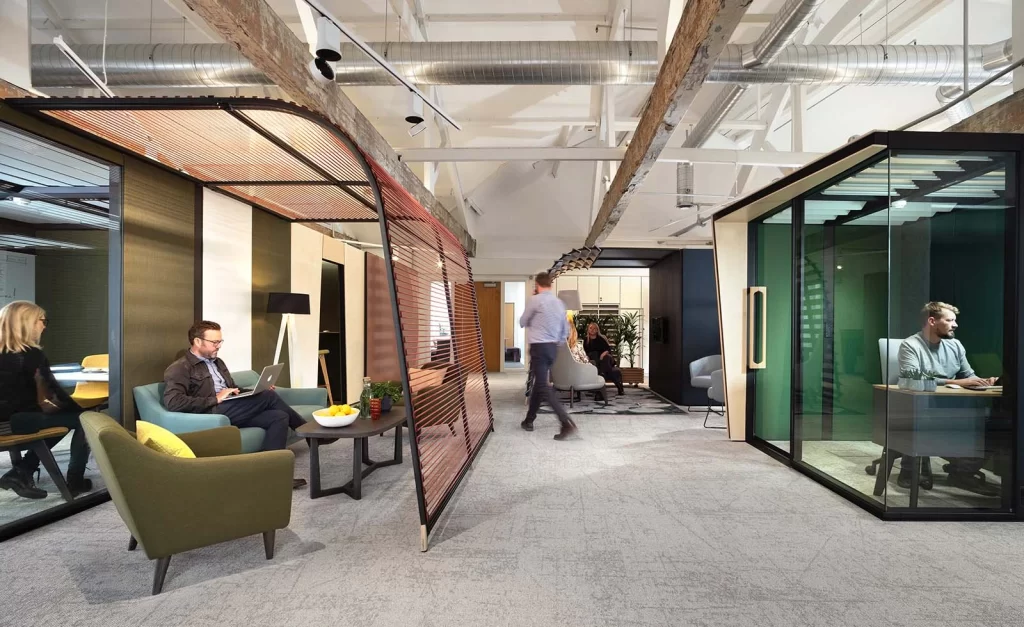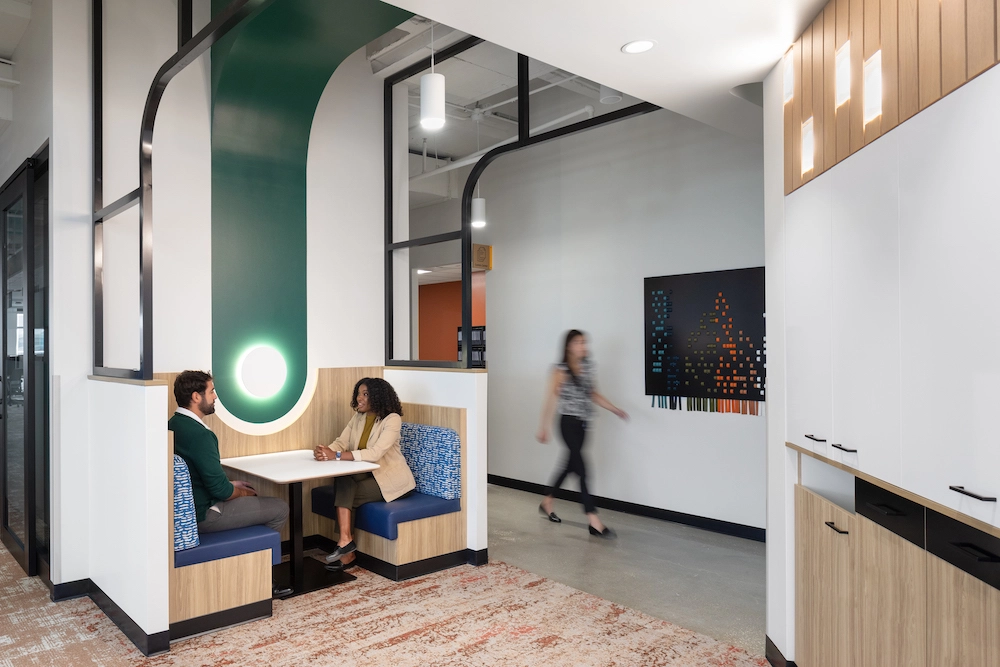Contents
- 1 Understanding Hybrid Workspaces
- 2 The Advantages of Hybrid Workspaces
- 3 Key Design Considerations for Hybrid Workspaces
- 4 Creating Flexible and Adaptable Work Areas
- 5 Technology Integration in Hybrid Workspaces
- 6 Promoting Collaboration and Communication in Hybrid Workspaces
- 7 Ergonomic Considerations for Hybrid Workspaces
- 8 Wellness and Well-being in Hybrid Workspaces
- 9 Case Studies of Successful Hybrid Workspaces
- 10 Embracing the Future of Work with Hybrid Workspaces
- 11 Author
In today’s rapidly evolving work landscape, hybrid workspaces have become the hot topic of conversation. As companies adapt to the changing needs of their employees, designing offices that cater to the future of work has become imperative. Gone are the days of rigid nine-to-five schedules and traditional cubicles. Instead, flexibility and collaboration are the new pillars of productivity.
Understanding Hybrid Workspaces
Hybrid workspaces are a contemporary work environment that strives for the best of both worlds. Hybrid workspaces give workers the freedom to work in the office as well as from a remote location. It implies that one can develop the environment autonomously while yet feeling like a part of the cohort. It is designed to strike a balance between personal work and collaboration. The hybrid workspace technique allows individuals themselves to determine when and how they work.
An assigned area or in the coziness of one’s own home could be used to complete the workload. It reduce’s an employee’s job satisfaction but also increases productivity. In addition, hybrid workspace enables people to have a better lifestyle because it eliminates busy commutes and offers a flexible timetable.

The Advantages of Hybrid Workspaces
In conclusion, hybrid workspaces have multiple advantages for both employees and employers. Employees benefit from the flexibility to work from any location possible as they obtain a great work-life balance and reduced stress, forget about daily hustle, and customize their comfort level to ensure higher productivity and focus. Employers, in turn, can open a new global talent pool not being restricted to the geographical location and can ensure diversity and inclusion in their organizations.
Moreover, due to the reduced need for an actual office space, companies can save on the office and can ensure the profitability of such an option. Finally, numerous surveys show that employees with location flexibility are more engaged and loyal to their employers.
Key Design Considerations for Hybrid Workspaces
Design is the key to an effective hybrid workspace. Each element, from the ergonomic furniture and adjustable lighting to the adaptable and collaborative areas, is carefully designed to maximize productivity and well-being. By incorporating smart technology and ensuring the comfort of the employees, a design for the future of work is created. Thoughtful space planning is the first step in creating a hybrid workspace. The space layout should be flexible and adaptable to allow easy change to suit the employees’ wants and needs.
Additionally, the position of collaborative spaces should facilitate interaction and idea sharing. The inclusion of various types of workstations such as standing desks and private pods, allows for a choice between setups, allowing the employees to work the way they feel most productive.
Creating Flexible and Adaptable Work Areas
Creating adaptable spaces is essential to the successful design of a hybrid workspace. The office environment should easily change to fit many types of configurations and employee preferences. Modular furniture, adjustable desks and chairs, and partitions on wheels are several strategies for flexible space. When given a choice over how to organize their area, staff can feel more comfortable and productive.
Adaptable space also takes into consideration the needs of employees who are not currently present. Conference rooms outfitted with technology and digital platforms that facilitate remote participation allow off-site employees to take part easily. Dedicate quiet areas that minimize disturbances without regard to each person’s location aids employees in getting quiet work done.
Technology Integration in Hybrid Workspaces
The success of hybrid workspace is impossible without technology. Connection without delays, opportunities to collaborate, and various other tools enable employees to work with their offices smoothly. High-speed internet, efficient and free video conferencing systems, and cloud-based document sharing help individuals communicate with no boundaries. As soon as one group of workers is available anytime, the other one can respond. Smart office technology is capable of improving the situation even more.
For example, automated lights and temperature controls can make an office more comfortable and energy-efficient. Occupancy sensors enable neat space utilization and help employ valuable resources. Digital signs and way-finding systems show them all the required data in real-time to not get lost in the office.
Promoting Collaboration and Communication in Hybrid Workspaces
On the other hand, effective collaboration and communication are vital in hybrid work environment. For Gevin , companies create collaborative culture by creating spaces that allow them to comfortably exchange ideas and work together. Open-plan layouts, huddle rooms and co-working spaces may be used to create opportunities for unplanned encounters and brainstorming sessions. Companies can fill the gap between in-office and remote employees with software that supports virtual meetups and project management. Team check ins, video conferences and other remote team-building events should be scheduled on a regular basis to ensure that employees continue to feel positive and engaged.
Ergonomic Considerations for Hybrid Workspaces
Hybrid workspaces should focus on the well-being of employees. Therefore, it is pertinent to buy quality furniture and equipment to prevent musculoskeletal disorders . Adjustable desks and chairs, monitor arms, and keyboard trays will help employees stand or sit properly to prevent injuries.
Moreover, the workplace must promote regular breaks and instigate continuous movements. For instance, standing desks or active seating affect movement and deter static postures Natural elements, such as plants and natural light, tend to effect an increase in wdbos.

Wellness and Well-being in Hybrid Workspaces
Finally, to build a workplace environment in hybrid work settings, it is necessary to create a well-supported and healthy working space. Wellness programs in the form of classes or mindfulness sessions and exercising classes boost the physical and mental well-being of workers. Relaxation space in the form of a meditation room or open-air areas will enable employees to relax and recover from work or escape from stress due to lack of personal area. Another significant suggestion is to improve the mental health of workers.
Namely, employee assistance programs and counseling services and flexible schedules will help people to handle stress and connect working and personal life. Combining all these aspects results in fostering healthy work and creating the best conditions that meet employees’ demands.
Case Studies of Successful Hybrid Workspaces
There are various examples of companies that have realized hybrid workspaces and benefited from the organizational setup. Automate Tech, a professional software development enterprise, reshaped its working places to offer a new totally flexible setup that encourages collaboration. With adjustable tables, special break areas with access to video conferencing tools, Automate Tech created a perfect atmosphere for its employees to engage in the thinking process and work as a team.
Another instance of a company utilizing hybrid workspaces is Global Marketing Solutions, a marketing agency specializing in digital campaigns. It decided to switch to a hybrid work model that allows its workers to operate from home or in the office. To move towards this end, Global Marketing Solutions needed to invest in technology that would allow its employees to stay connected without losing the team spirit.
Embracing the Future of Work with Hybrid Workspaces
The future of work is here, and it’s time to design offices that reflect this exciting new era. Hybrid workspaces are the perfect solution for companies looking to capitalize on current work trends and remain competitive into the future. With an emphasis on flexibility, collaboration, and technology, organizations can design work environments that enable their employees to be both inspired and productive.
Deciding how to design an office for the present and future entails space planning, ergonomic design, and attention to the staff’s health and well-being. This, however, will enable organizations to create hybrid workspaces that breathe functionality and creativity.
Also read: Roti Sourdough: Mengenal Sejarah, Proses, dan Keunikannya



